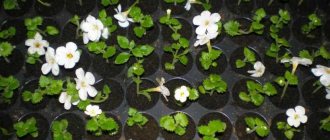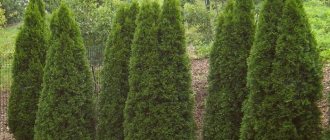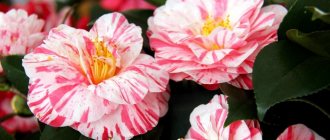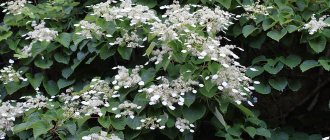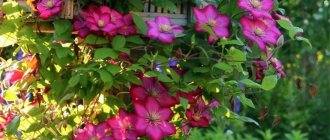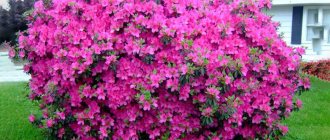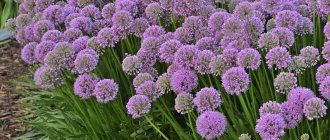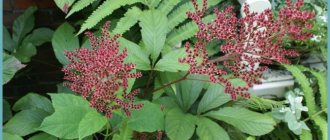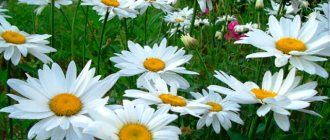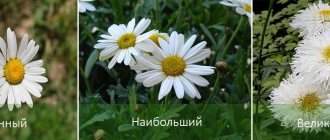Lingonberry - main characteristics and description of the plant
Lingonberry is an evergreen shrub that is classified as a member of the Heather family. Its bushes are small, reaching a height of up to 15 cm. The leaves are alternate, obovate or elliptical. They reach a maximum length of up to 3 cm and a width of up to 1.5 cm. The upper leaf plate is painted dark green, the lower one is light green. They grow on short petioles.
The roots of the plant are located horizontally. They have slightly raised branched shoots 15–20 cm high. A fungus settles on the rhizome, which forms mycorrhiza with the plant. It absorbs minerals and then saturates the root system of berry bushes with them. During flowering, which occurs in May–June, inflorescences are formed in the form of drooping racemes, in which 10–20 flowers are collected. The corolla is white or pale pink. The calyx is divided into 4 triangular lobes. There are 8 stamens.
Fruiting occurs in late summer - early autumn. The fruits are spherical in shape and up to 8 mm in diameter. They have shiny red skin. The taste of the berries is sweet and sour.
The yield of berry bushes can be 50–60 kg per hundred square meters. Lingonberry leaves and shoots are used in folk medicine as a disinfectant, urinary, choleretic, anthelmintic agent. The berries are eaten, jam, jam, fruit juice, and filling for baked goods are made from them.
This culture has the following characteristics:
- frost resistance;
- unpretentiousness to the composition of the soil;
- poor tolerance to drought.
Did you know? Lingonberry is a long-lived plant. It can grow for 200–300 years.
Varieties of garden lingonberries
As mentioned earlier, foreign breeders have been especially active in breeding forms of garden lingonberries in the last 50-70 years. But in Russia, three varieties of garden lingonberries are currently registered in the State Register of Breeding Achievements:
- Kostroma pink;
- Ruby;
- Kostromichka.
Although these varieties are inferior to imported ones in yield, height of bushes and size of berries, they take root and feel themselves in Russian conditions, according to gardeners, sometimes better than their foreign counterparts.
Description of lingonberry Belyavskoe fleece
The garden lingonberry variety was bred by Polish breeders in 1996. It forms low, but compact and dense spherical bushes, reaching 20-25 cm in height and width. It is characterized by early ripening: from mid-August to early September. The berries are quite large, oval in shape, ranging in size from 9.5 to 11 mm. They have a sour but mild taste.
The variety is also distinguished by its self-fertility and high yield (up to 300-350 g per bush). Tolerates frosts well.
Judging by the reviews, the lingonberry variety Belyavskoye Fleece is in demand among gardeners, primarily due to its frost resistance, high yield and attractive taste.
Coral
This variety, originally from the Netherlands, is considered the very first garden form of lingonberry obtained in cultivation. It was registered back in 1969. Despite its rather advanced age, Coral is still popular due to its high productivity and decorative value.
Its berries are not the largest (up to 0.9 cm in diameter), but a lot of them ripen. In addition, the bushes are remontant, that is, they can produce 2 harvests per year. The first harvest is small, it ripens in late July or early August. The second harvest produces the largest number of berries in late September or early October. In total, one bush can produce up to 400 g or more berries per season.
Important! Coral bushes are especially decorative in August, when both flowers and fruits are observed in abundance on them.
The bushes are distinguished by erect shoots more than 30 cm long. Daughter rosettes are poorly formed.
Red Pearl
Another Dutch variety of garden lingonberry, registered already in 1981. The berries are large in size, up to 12 mm in length. And the bushes themselves and the leaves are relatively large in size. It is also capable of producing two crops per season, but the yield is slightly lower than that of Coral.
Sanna
This variety of garden lingonberry was bred in Sweden, in the province of Småland in 1988. Its distinctive feature is the intensive formation of daughter rosettes on underground shoots. Thanks to this, soon after planting one plant, a whole carpet of lingonberries can form in the garden bed. The berries are quite large, round in shape, reach 0.4 g in weight, and ripen in mid-August. From one bush you can get 300-400 g of lingonberries. This is the most productive variety of Swedish garden forms.
Kostroma pink
This Russian variety of garden lingonberry is characterized by the largest berries. Their diameter reaches 10 mm, and some weigh up to 1.2 g.
The bushes are small in height - up to 15 cm. They are self-fertile and early ripening, ripening in mid-August. The yield of lingonberries varies depending on growing conditions from 800 g to 2.6 kg per square meter.
Ruby
Considered the most promising lingonberry variety of garden Russian selection, it is capable of bearing fruit twice a year. True, in the conditions of the Kostroma region this does not always work out due to early autumn frosts. It was obtained, like all other Russian lingonberry varieties, in 1995. The berries are medium in size, reaching 0.6 g. The yield, therefore, is up to 2.9 kg/sq. m. per season. The bushes are low - up to 18-20 cm.
Underground shoots are actively formed by children, so the variety can be used as a ground cover plant. Ruby is classified as a self-sterile variety, therefore, it requires the obligatory presence of insects (bumblebees) on the site.
Kostromichka
The Russian variety of garden lingonberry, Kostromichka, is also distinguished by its low bushes. Its advantage is its early ripeness; the berries ripen in the first half of August. They are medium in size (diameter about 8 mm, weight about 0.3-0.5 g). However, the yield can be up to 2.4 kg/sq. m.
Garden lingonberry varieties for the Moscow region
In the conditions of the Moscow region, almost any variety of garden lingonberry should have enough heat and light to not only grow and bear fruit well, but also produce two harvests per season, if it has the potential to do so.
In addition to those described above, the following varieties of garden lingonberries can be planted in the Moscow region:
- Erythkrone, a variety from Germany that is capable of producing two harvests per season.
- Eritzegen, also a German variety, is distinguished by its especially large (more than 1 cm) and sweet-tasting berries.
- Ammerland, another German variety of garden lingonberry, forms tall spherical single bushes, 30 cm in diameter. It is distinguished by a fairly high yield (up to 300 g per bush) and double fruiting.
The remaining known varieties are not distinguished by such high yields, but can be quite used for decorative purposes.
Selecting a site and preparing the soil for planting
Lingonberries need well-lit areas. If you plant it in the shade, the yield level and quality of the fruit will be significantly lower, so it is not recommended to plant shrubs under trees. The area should be open and well ventilated, but at the same time protected from drafts and northern winds.
When choosing a place for planting, you should inquire about the level of groundwater. Berry bushes grow poorly and often get sick if they get closer than 40–60 cm to the surface of the ground. If the groundwater is higher, then good drainage should be organized to remove excess moisture and high beds.
You should not add lime and manure to the soil on the site, since the soil fungus that entwines the roots of lingonberries reacts poorly to them.
Lingonberries do not have any special requirements for soil composition, but they produce the best yields when planted in light, loose, acidic soils that conduct water and air well. It is best to plant it in peat bogs and sandy loam. Heavy, clayey, loamy soils are unsuitable for growing lingonberries. Site preparation must be done in the fall or 2-3 weeks before planting.
For seedlings, you will need to dig a planting hole 30 cm deep (about the size of a shovel). It is necessary to leave 25–30 cm between plants, and 30–40 cm between rows.
The soil dug out of the hole should be mixed with peat, sawdust, pine needles, and sand. Recommended soil mixture compositions for the hole:
- high-moor peat + coarse river sand in a ratio of 3 to 1;
- high-moor peat + coarse river sand + sawdust + pine needles in a ratio of 2:1:1:1.
If the soil is too poor, then it should be fed with rotted compost (2 buckets/m²), acidic peat chips (5 buckets), nitrophoska (2 tbsp.), superphosphate (2 tbsp.). Some gardeners recommend watering it with a solution of citric acid (100 g/3 l of water), apple cider vinegar (200 ml/10 l of water). These products will require 10 liters per 1 m². You can also add sulfur (10–15 g/m²) to acidify the soil. After applying fertilizers, the soil should be well leveled.
Planting a plant: soil composition and special conditions
In nature, lingonberries live on fairly acidic, well-moistened soils. Like other heathers (cranberries, blueberries), its roots alone cannot cope with the task of providing the plant with water. But this works well for soil fungi, with which lingonberries enter into symbiosis - mutually beneficial cohabitation. Therefore, the best soil for the plant is taken from under natural lingonberries and therefore saturated with mycelium of the required type.
For planting, it is better to purchase bushes with a closed root system. They will take root better, since the roots will not be damaged, and the soil ball is already populated with the necessary mushrooms. Planting is done in April-May and the seedlings are covered with film on the frame for a couple of weeks.
The planting scheme is determined not so much by the needs of the plants, which will soon fill the rows anyway, but by the convenience of the gardener. Row spacing is arranged from 30 to 50 cm, the distance between seedlings is from 15 to 30 cm. If the site is located on a raised or transitional bog, bushes can be placed less frequently, and to quickly close the crowns in decorative flower beds - more often.
Selection of planting material
It is important to choose the right variety for cultivation, taking into account the climatic conditions in the region. Most varietal specimens of domestic selection are suitable for the middle zone. Among the foreign varieties that grow in this climate are Sanna, Ida, Red Ammerland, Linnea, Susi, etc. For those who want to enjoy delicious fruits for a long time, it is recommended to take a closer look at the remontant lingonberry, which bears fruit twice a season.
Among the best remontant varieties are Coral and Ruby.
Lingonberry seedlings are sold in containers and with open rhizomes. Planting material with closed roots can be planted throughout the growing season. If you follow the recommendations for planting and selecting a good site, such seedlings quickly take root and grow. They are transplanted into the garden or garden without destroying the earthen coma.
Open seedlings must be planted soon after purchase. During the purchase, you should evaluate their condition: carefully examine the rhizome, trunk, and root collar. All organs should look healthy, there should be no stains, growths, or rot on them. The root system must be well developed. Before transportation, to prevent the roots of the seedlings from drying out, they must be wrapped in moistened sphagnum moss.
Planting lingonberries: features
The technology for planting lingonberry seedlings is as follows:
- Place the planting material in the center of the hole.
- Distribute the root system evenly.
- Fill the hole to the top with soil mixture.
- Lightly stamp.
- Water.
- Lay a layer of mulch 3–4 cm high from peat, cedar husks, pine bark, and sawdust. For sandy soil it is better to use peat and sawdust, for peat soil - fine gravel and coarse sand.
If planting is carried out in the spring, the seedlings must be protected from return frosts. To do this, it is worth stretching agrofibre on metal arcs. The cover will need to be removed when the seedlings are well rooted, after about 2 weeks. When planting seedlings in summer, they also need to be covered with translucent fabric to protect them from the aggressive sun. The plant must be accustomed to the sun's rays gradually, opening the shelter for a while every day.
Read the information about the difference between lingonberries and cranberries.
Care
The key to a stable and abundant harvest of lingonberries is competent and regular care. It consists of watering, fertilizing, pruning, loosening, weeding, mulching, preventive treatments against diseases and harmful insects. Since this is a winter-hardy crop, there is no need for shelter for the winter. It survives frosts well under snow cover. But in early spring, when there is a threat of frost returning, shelters with lutrasil or other non-woven material are needed. Low temperatures at this time can be destructive for bushes.
Video: How to properly care for lingonberries
What to feed
It is often not worth feeding lingonberries. 1-2 times per season will be enough. When grown in peat soil, you can fertilize once every 2–3 years. Berry bushes respond well to mineral fertilizers and complex mixtures. Recommended complexes include Ogrod 2001 granules, which are designed specifically for plants from the Veresaceae family, Kemira and Mortar products. The first application of fertilizers is carried out no earlier than 3 years after planting the seedlings in the ground.
Mineral fertilizers
From mineral fertilizers, after the snow melts, it is recommended to apply ammonium sulfate (0.5 kg/m²), potassium sulfate (1 kg), superphosphate (1.8 kg). Before flowering, you can add ammonium sulfate again, and after the flowers fall off, you can add manganese and zinc sulfate (0.1 kg).
Organic
There is no need to feed lingonberry bushes with organic fertilizers, namely manure or bird droppings. They contain a lot of nitrogen, which can cause burns on the root system.
It is strictly forbidden to feed lingonberries with chlorine-containing fertilizers. Chlorine is destructive to this berry crop.
Watering
Lingonberries love moisture, but do not tolerate stagnation. To take this feature of the plant into account, it is best to organize drip irrigation of the area. Irrigation is recommended to be done 2 times a week. Too frequent watering is undesirable. You should pay attention to the fact that moisture over time washes out from the soil the acid necessary for the normal growth and development of lingonberries. Therefore, once every 3–4 weeks you should water the soil with acidified solutions.
Watering must be combined with loosening. Since the root system of the berry crop is located in the upper layers of the soil, they must be shallow and neat.
Loosening is necessary to prevent the appearance of a dense crust on the surface of the soil, which prevents the normal passage of moisture and air to the rhizome. To reduce the number of watering, loosening and weeding, beds with lingonberries should be covered with mulch once every 2–3 years. Mulching allows you to maintain the required level of soil moisture and inhibit the growth of weeds.
Growing lingonberries from seeds at home
If you decide to grow garden lingonberries from seeds, then the easiest and most reliable way to do this is at home.
Recommended sowing dates
Garden lingonberry seeds are able to actively germinate only after stratification. Since stratification usually takes 4 months, it must be started in advance, in November-December. At this time, the seeds selected from the fruits are washed and mixed with wet sand. The container with the seeds is placed in a refrigerator or other cold place where the temperature is constantly maintained at about + 4 °C.
Sowing begins after four months, that is, approximately in March or April.
Preparing soil and containers
For sowing garden crops, you can use any plastic or ceramic containers. Their volume depends on the number of seeds sown. Typically, half-liter or larger containers are used.
The ideal composition for germinating lingonberry seeds:
- 3 parts sphagnum peat;
- 2 parts sand;
- 1 part perlite.
Important! It is necessary that the acidity of the soil for sowing lingonberry seeds be in the range from 3.5 to 4.5.
Drainage (expanded clay, fine gravel) is usually placed at the bottom of the containers in a layer of about 1 cm, then the prepared soil is poured and watered with snow or rainwater to compact it.
How to plant lingonberries correctly
The most important feature of lingonberry seed propagation is that its seeds germinate only in the light. Therefore, under no circumstances should they be sprinkled with soil on top.
- Typically, grooves are made in the prepared and slightly compacted soil mixture, several millimeters deep.
- Lingonberry seeds are poured into the grooves.
- The container is covered with polyethylene on top and placed in a well-lit place with a temperature of about + 20 °C.
- The film is periodically lifted to ventilate and check the soil moisture.
- If necessary, moisten the soil.
- The first shoots may appear on days 12-15, but the appearance of the rest may well take 4 weeks.
- After a month, the film can be finally removed.
Rules for growing lingonberries at home
When lingonberry seedlings form 4-5 leaves, it is advisable to plant them in boxes, maintaining a distance of 5 cm from each other.
In the first months, young lingonberry plants need a lot of light and relatively little heat. They should not be placed in a room that is too warm. The ideal temperature would be from + 15 °C to + 20 °C.
Humidity should also be moderate, but it is not advisable to let the soil dry out.
Attention! Lingonberry seedlings do not require any fertilizing before transplanting into the ground.
Already in the first season they can begin to branch. It is best to keep young lingonberry plants for the entire first year of life in a box at home, without planting them in open ground. And only in the second season can the seedlings be carefully transplanted into a seedling bed prepared in advance. Or you can plant them in separate containers that will overwinter in a greenhouse.
Only in the third year of life is it recommended to plant lingonberry seedlings in a permanent place of growth.
Trimming
Pruning shrubs is necessary to prevent the development of diseases and attacks of harmful insects, and the normal development of the plant. Lingonberries require sanitary pruning in spring and autumn, when the growing season has not yet begun or has already ended. During them, diseased, twisted, dry, damaged branches are cut out, as well as those that no longer bear fruit. Anti-aging pruning is carried out every 8 years. During this process, the plant is pruned to a stump 4 cm high. Fruiting of the pruned bush occurs a year later.
Proper care of lingonberries is the key to a stable harvest
To get strong berries rich in vitamins and microelements in open ground, you should not leave lingonberries to their own devices. During the entire growing season, agrotechnical care operations must be performed, the most important of which are listed below.
Lingonberries need mulching
- Mulching. A thick layer of softwood chips allows you to cope with weeds without the use of herbicides or exhausting manual weeding.
- Watering. Lingonberries are moisture-loving, but excess water in the soil and ground layer of air is unfavorable for it, as it provokes fungal diseases. If it is possible to organize drip irrigation in open ground, it is worth using it.
- Proper wind protection. The absence of a strong cold wind allows lingonberries to ripen earlier, but it is not worth planting a solid wall of trees around the plots so that the plants are ventilated after rains or watering.
- Trimming. Starting from about the age of seven, lingonberries are periodically subjected to anti-aging pruning, which has a very beneficial effect on the longevity of plants and the quality of the harvest.
Advice. Adding 4-5 cm of mulch when caring for lingonberries in the fall will prevent the plants from bulging out of the soil.
Pest and disease control
If mistakes are made during planting or care recommendations are ignored, lingonberry bushes can be affected by diseases and harmful insects. The main diseases of this berry crop are:
- Exobasidiosis: coloring of leaves pinkish or whitish; strong growth of foliage; damage to stems, peduncles, flowers. Prevention and treatment: spraying three times with Bordeaux mixture: before flowering, at the end of flowering, 2–3 weeks after the second treatment; prophylaxis with the drug “Rovral” (0.1%): before and after the growing season; treatment with “Euparen”, “Benomil”.
- Mycospheriliosis: formation of reddish spots on the leaves. Prevention and treatment: Three-time spraying with Fundazol and Topsin with intervals of 1–1.5 weeks.
- Sclerotinia: mummification of fruits. Prevention and treatment: Application of “Topsin” (0.2%), “Euparen” (0.2%): 3 times before flowers bloom at intervals of a week, 3 times after harvesting; use of Bordeaux mixture: before and after the growing season.
- Rust: the formation of brown spots on the foliage. Prevention and treatment: Bordeaux mixture is used to prevent infection in spring and autumn; For prevention, a 1% solution is suitable, for treatment - a 3% solution.
- Monoliosis: drying of stems; deformation of shoots, leaves, flowers. Prevention and treatment: the same measures as for mycospheriliosis.
- Gibber spot: the appearance of a black crust on the ground organs; drying out of the plant. Prevention and treatment: treatments with Fundazol, Topsin, Bordeaux mixture.
The greatest danger to the growth and development of lingonberries is posed by the following insects:
- Leaf roller. The butterfly caterpillar is yellow-brown in color. Colored gray-green or yellow-green. Symptoms of infection: damage to buds, buds, ovaries, leaves; rolling leaves into a tube. Prevention and treatment: spraying with decoctions of tomato tops, wormwood, onions, garlic; three-time treatments with insecticides “Karate”, “Decis” during the formation of buds with an interval of 1-3 weeks.
- Aphid. A miniature sucking insect with body dimensions up to 0.6 mm. It can be green or black, with or without wings. It feeds on plant juices. Symptoms of infection: yellowing, curling, drying of foliage; the appearance of honeydew on ground organs; stopping shoot growth. Prevention and treatment: timely removal of ants that carry aphids from the area; treatment of ground organs with soap solution; use of "Rogora", "Aktellika".
- Leaf beetle A small or medium-sized beetle with a body size of 3–15 mm and bright coloring. Symptoms of infection: leaves eaten away to the veins. Prevention and treatment: Use of onion, dandelion, tobacco infusions; treatment with “Aktellik”, “Phosbucid”, “Kemifos”.
- Shield. A small gray insect with a hard shell. It feeds on plant juices. Symptoms of infection: the appearance of dark spots on ground organs; drying out of the plant. Prevention and treatment: use of drugs “Karbofos”, “Aktara”, “Tanrek”; spraying with coniferous or citrus tincture.
Medicinal properties of lingonberries
Useful properties of lingonberries photo berries
Due to the presence of beneficial substances and vitamins, lingonberry leaves have a powerful wound-healing, antimicrobial, tonic, diuretic and anti-inflammatory effect.
The leaves and fruits kill viruses and have an antipyretic effect - what is needed in the treatment of colds, flu, and acute respiratory viral infections. The bitterness present in the taste of this priceless berry causes an increase in appetite, so this is an indispensable product for children and people weakened by illness.
Infusions and decoctions of the leaves are used to rinse the mouth and throat, which effectively helps fight many infections (in particular, staphylococcal infections). Also, taking them lowers the concentration of sugar in the blood - very useful for people suffering from diabetes.
Lingonberries are most often used as a diuretic in the treatment of kidney and bladder diseases. Daily long-term use of tea and decoction of leaves and berries helps to completely cure urinary tract infections. Berries also help get rid of rheumatism, gout, diarrhea; As a valuable source of protein, they are recommended for people on a diet.
- Lingonberry jam is a delicious cure for prostatitis.
- The tincture helps in the treatment of hypertension, chronic gastritis, and fever.
- Lingonberry juice, like berries, is useful for vitamin deficiency and high blood pressure.
Preparation of medicinal raw materials
For subsequent preparation of a medicinal decoction, the collection of medicinal raw materials (leaves) is carried out in the spring before flowering begins. Collect overwintered ones, since young leaves will turn black after drying. Secondary collection can be carried out in the fall after fruiting.
Carefully pluck the leaves from the stems so as not to injure the plant. Re-harvesting is possible 5 years after the bush has been completely restored.
Before drying, sort out the blackened leaves. Spread high-quality leaves on a cloth or newspaper and dry in a warm, shaded place with good ventilation.
Reproduction
Lingonberries are propagated in three ways:
- seed;
- dividing the bush;
- cuttings.
The most labor-intensive and time-consuming method of propagation is by seeds. It is produced as follows:
- Conduct stratification (holding at a temperature of +4...+5°C in wet sand) of planting material for 4 months.
- Sow the seeds in a container filled with a mixture of peat and sand.
- Place in a well-lit place where the temperature is maintained at +20°C.
- Moisten with a spray bottle.
The emergence of seedlings must be expected after 2–3 weeks.
All this time they need to be periodically moistened. When the seedlings get stronger, transplant them to a permanent place along with a lump of earth. The first fruiting of plants propagated in this way occurs 4–5 years after planting. About
How do garden lingonberries reproduce?
Lingonberries can quite easily propagate generatively (by seeds) and vegetatively (by green and woody cuttings, underground rhizomes and children).
Seed method
Under natural conditions, young lingonberry plants, hatched from seeds, appear around June-July. At home, sprouts can begin to develop in the spring.
In general, propagation by seeds allows you to obtain a considerable number of seedlings ready for planting almost free of charge, especially since lingonberry seedlings are very expensive (about 500 rubles with a closed root system). In addition, seeds usually produce plants that are stronger and more adapted to specific growing conditions.
Attention! The germination rate of lingonberry seeds after stratification is about 70%, without stratification - 40%.
But this method of reproduction also has disadvantages:
- Bushes grown from seeds can wait at least 4-5 years to bear fruit.
- This activity is quite labor-intensive and the first two years the seedlings require constant attention and can die due to any oversight.
- Plants grown from seeds do not retain the characteristics of their variety, so anything can grow from them.
Propagation of lingonberries by cuttings
Both green and woody cuttings of garden lingonberries are suitable for propagation.
Green cuttings are usually harvested in mid-July, while woody cuttings are harvested at the end of March, in April - during the period of swelling of the buds.
After cutting and before planting, they can be stored in moist sphagnum moss at a temperature of 0 to + 5 ° C.
It is best to root cuttings in greenhouse conditions in loose and acidic peat-sandy soil. The length of the cuttings should be from 5 to 8 cm.
The lower leaves are torn off, leaving only the upper 2-3 buds, which are located above the surface of the soil. The rest of the cutting, pre-treated with Kornevin or another stimulant, is placed in the ground.
The top of the cuttings should be covered with film on the arches and additionally insulated with non-woven material if the weather is cold.
Roots may appear within 3-4 weeks, but final rooting occurs within several months. The soil must be kept moist at all times and the plants must be sprayed periodically. By autumn, the bed with cuttings is covered with a layer of mulch and again insulated with covering material.
Next year, in the spring, the rooted cuttings can be transplanted into pots or into a special bed for growing.
Depending on the care conditions, the rooting rate of such cuttings can range from 50 to 85%. The first fruits may appear on them in 2-3 years.
Since quite a lot of cuttings can be cut, and the resulting bushes retain all the properties of the mother plants, this method of propagation is more popular among gardeners.
Propagation by rhizomes
In exactly the same way, you can take cuttings in early spring from underground shoots or rhizomes of garden lingonberries. They are cut 10-15 cm long so that each has at least one bud or shoot rudiment. Plant the cuttings to a depth of about 10 cm in loose and acidic soil. Otherwise, caring for the resulting bushes is the same as described above. The rooting percentage is usually around 70-80%.
Reproduction by layering
Since some varieties of garden lingonberries have an increased ability to form children, this is often used for propagating bushes. You can get up to 10 cuttings from one plant. You can also separate the babies in early spring or autumn. In the first case, they are traditionally planted on a seed bed and by autumn they form full-fledged plants. During the autumn separation, the children are placed in pots and left to winter in a frost-free room. The survival rate of seedlings with this method of propagation is usually 85-100%.
Therefore, propagation by layering is the most reliable way to propagate lingonberries. But you won’t be able to get many seedlings this way.
Harvest and storage
Fruiting of lingonberries begins in the second year after planting. Harvesting begins in September. It can be carried out until the first frost. It is important to pick fully ripe berries, since unripe fruits will no longer reach ripeness once picked. It is necessary to plan picking in the morning or evening so that the skin of the berries is completely dry. It is important not to harvest in hot weather, as this significantly reduces the shelf life of the fruit.
Did you know? In some birds, lingonberry berries are not digested by the digestive tract, so the seeds are excreted unchanged in the droppings. This way they can spread over long distances from the mother plant.
The berries are picked by hand, placing them in small containers. After harvesting, they should be placed in cool conditions as soon as possible. You can store berries indoors, but it is better to do this in the refrigerator. The shelf life of fruits stored in the cold is 2–3 months.
To preserve the berries longer, they can be dried or frozen. The dried product can be consumed for two years, frozen - for a year. You can also boil lingonberries and make jam from them, grind them with sugar or soak them.
So, growing lingonberries in summer cottages and garden plots is not difficult. The main thing is to choose a good site, plant the plant in the recommended soil and provide high-quality care. If these rules are followed, berry bushes will delight you with abundant and regular harvests for a long time.
Is it possible to grow lingonberries in a garden plot?
It was the significant increase in yield when trying to grow garden lingonberry in cultivation that forced breeders to come to grips with developing its garden forms.
Back in the middle of the last century, almost simultaneously, Swedish, German, Dutch and American breeders took up this process. At the moment, there are already more than 20 varieties of garden lingonberries, which differ not only in their significant yields, but also in the larger size of the berries and the height of the cultivated bushes.
At the same time, the requirements for planting and care for wild and garden lingonberries are almost identical.
- Lingonberries can grow well and bear fruit only in acidic and well-drained soils with a minimum organic content.
- Humidity conditions in the root zone should correspond to the “golden mean”. If it is too dry, especially at high air temperatures, the lingonberry bushes will die. On the other hand, with constant waterlogging of the soil, they will also die, primarily from a lack of oxygen exchange in the soil.
- Garden lingonberries adapt quite easily to any air temperature. But in extreme heat, it will require more abundant and regular watering, and the berries may still become smaller.
- Neither garden nor wild lingonberries are afraid of frost; they tolerate temperatures down to -40 °C in winter. The only thing is that its flowers can suffer from frosts in late spring or early autumn (they cannot tolerate temperatures below - 4 ° C).
- Lingonberries love good light, and in partial shade the yield will decrease and the berries will become smaller.
- Under no circumstances should lingonberry bushes be overfed - under natural conditions they grow on very poor soil.

